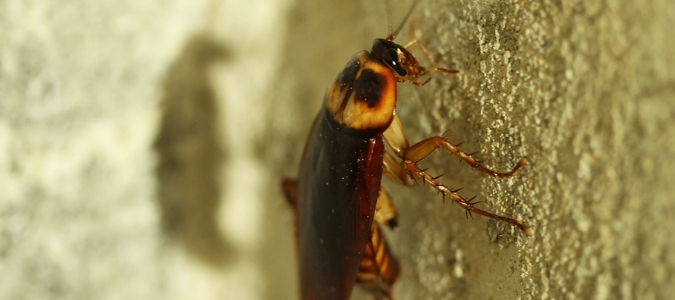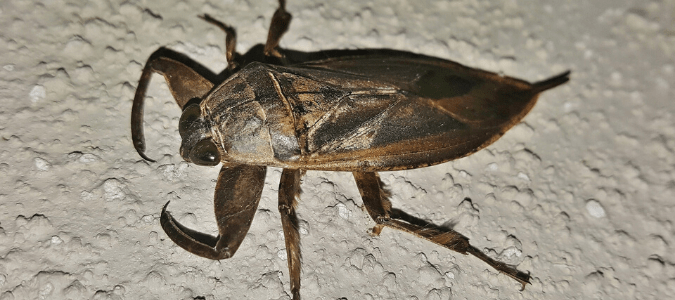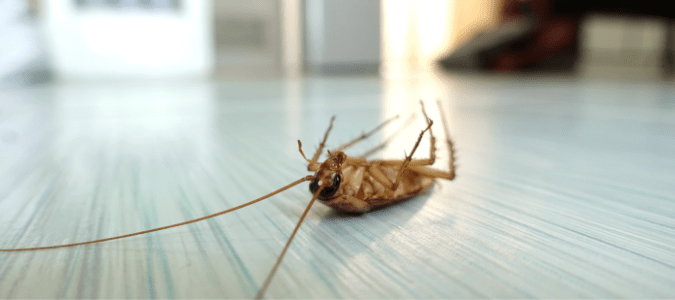
When you see a large bug darting across the floor or—far worse—your kitchen counter, your initial response might be simply to shriek, leap around in fright or maybe take a few wild swings at it with a shoe. But later, when you’re able to think more calmly, you might start wondering exactly what kind of bug it was. Was it a cockroach or a water bug, or something else altogether? There’s plenty of confusion in the great water bug vs. cockroach debate, and for good reason: While these two bugs are distinct from one another, it can be hard to tell the difference between them—especially when you’re in the midst of an unwelcome encounter with one of these creatures.
Fortunately, there are several ways to determine whether you have cockroaches or water bugs on your property. Once you know which type of pest has invaded your personal territory, you can figure out what to do next—meaning, how to get rid of them and prevent them from ever coming back. The following are some of the key differences between cockroaches and water bugs, including differences in what they look like, what they eat and their general habits and behavior.
Differences In Size
If you’re wondering whether you’ve spotted a water bug or a cockroach, your first clue may come from the insect’s size. While water bugs and cockroaches are both large, brown, oval-shaped insects, water bugs are typically bigger than cockroaches—sometimes, quite a bit bigger. An adult water bug is about two inches long, and sometimes up to three or even four inches long. Cockroaches vary in size, depending on which type they are, but they rarely grow as large as water bugs. German cockroaches are the smallest, at about half an inch to three-quarters of an inch long, while Oriental and American cockroaches are larger, though still not as big as water bugs, at about one to one-and-a-half inches in length.
Differences In Color
Color is another clue about which type of bug you’ve spotted. Water bugs are medium brown in color, while American cockroaches, as pictured above, are a darker, more reddish-brown color, and Oriental cockroaches are so dark brown that they’re almost black. German cockroaches are closer in color to water bugs, but they are so much smaller that they aren’t easily confused with water bugs. However, the two could get confused if someone thinks they’ve spotted a baby water bug rather than a full-grown German cockroach.
Differences In Behavior
Perhaps surprisingly, and quite unlike all varieties of cockroach, water bugs are not technically considered pests. This is because they perform a beneficial function as a predator of other, actual pests such as mosquitoes. They also prey on small fish, salamanders and amphibians, keeping these populations low. Water bugs feed by hiding in plants either in or near water, lying in wait and using a natural breathing tube if necessary until they attack their unsuspecting prey. Although water bugs can eat different pests around your property, you typically don’t want large populations of these insects hanging around your pool, especially when you take into account that water bug eggs can fully develop into adults in as little as one month.
Water bugs are called “electric light bugs” by some because these insects are attracted to light. Though they typically live out their lives in creeks, ponds and other bodies of water, water bugs are also often seen hanging around porch lights or in parking lots beneath street lamps. This is in contrast to cockroaches, which tend to hide away from light and come out mostly at night. Water bugs are also sometimes called “toe biters,” since they have been known to bite people when handled. For this reason, it’s a good idea to give these bugs a wide berth.
While they might bite people from time to time when provoked, water bugs do not carry dangerous diseases or transmit illnesses to humans. Conversely, while cockroaches don’t bite, they are capable of making people sick. It is well known and documented that if allowed to infest a home or other living space, cockroaches can cause allergic reactions and asthma in people, especially in children. They have also been found to carry pathogens that can cause dangerous diseases such as typhoid, dysentery and even polio.
Cockroaches are attracted to people’s homes because of the ready availability of food and water. Cockroaches can feed on just about anything—everything from fruits and vegetables to dropped crumbs, grease splatters, book bindings, cardboard boxes and more. Keeping your home clean, and especially your kitchen, can go a long way toward keeping cockroaches at bay. Although if you’re dealing with a serious problem, you’ll have to do more than just simple cleaning to get rid of a roach infestation.
Products available at your local grocery or home improvement store can have varying success in reducing roach populations, but you have to be careful to use them exactly according to directions on the package. Also be extra careful with products such as insecticide foggers, since these can spread potentially harmful chemicals throughout your home without actually reaching the insect pests they’re intended to kill. Furthermore, many commercially available insecticides target cockroaches only in certain stages of their life cycle but not others, leaving your home vulnerable to continuing problems.
German cockroaches, in particular, are notoriously difficult to eliminate. If you’re dealing with an infestation, whether of German, American or Oriental cockroaches, your best course of action is to reach out to a pest management specialist. These licensed professionals can make a thorough inspection of your property and locate where roaches are hiding. Then, they will be able to implement effective pest control methods to ensure you won’t have to have any more run-ins with these creatures.
When dealing with insects like water bugs and cockroaches, one of the best ways to prevent another encounter is by preventing them from entering in the first place. But, of course, first you must learn how these insects get into your home. Keep reading for more information on how these creatures get into your house and how to keep them out.

How Do Water Bugs Get Into The House?
Water bugs are attracted to light—this is why many people call them electric light bugs—so if they venture into your home, they likely followed a light, such as a porch light, to get there. Water bugs that make their way into people’s homes generally do so completely by accident. They are water-based animals, preying on insects and other small animals that live outdoors in creeks and ponds. If they get into your home, they probably just want to get back outside again.
How Do Cockroaches Get Into The House?
Cockroaches, on the other hand, thrive in people’s homes. They might also make their way there by accident from the outdoors, since many types of cockroaches do live outside, feeding on plant matter and nesting in the underbrush. But cockroaches can live a very good life inside your home, with access to your food, your pets’ food and various sources of water to keep them alive. Preventing cockroaches from entering your home and making it their own is easier than getting rid of them once they’ve moved in. To keep cockroaches away from your home, follow these steps:
- If you live in a brick home with weep holes, use steel wool to plug these gaps and prevent roaches and other small pests from getting inside.
- Make sure all windows, doors and screen doors close thoroughly and have screens that fit well and are free of tears, holes or gaps.
- Keep your kitchen as clean as possible, regularly wiping away any grease and crumbs off counters, sweeping and mopping the floors and storing all food appropriately, including inside the pantry. Grains, cereal and other items in the pantry should be stored in airtight containers to keep them unavailable to hungry insects. Store pet food in airtight containers as well, and empty and refresh pets’ water bowls regularly.
- Fix any leaking faucets or pipes, as these can be popular “watering holes” for cockroaches.
Taking these steps can also help keep other unwelcome insects, such as ants and spiders, away from your property and can help with reducing the number of cockroaches infesting your home. If you’re taking these measures and you still have a cockroach problem, there are a few other things you can try. However, typically the fastest and easiest way to eliminate any invading insect or animal from your property is by contacting a licensed professional to control your pest problem.

How To Get Rid Of Water Bugs And Cockroaches
It’s important to know how to get rid of water bugs and cockroaches—and keep them from coming back—because these insects reproduce quickly. While water bugs are happier living outside in their natural habitat, cockroaches can live a very comfortable life inside your home, as long as they have access to food and water. Most people’s homes provide plenty of both, which is why so many people have dealt with pest infestations.
One reason German cockroaches are such an enduring problem in people’s homes is the fact that they lay so many eggs at one time. American and Oriental cockroaches are bad enough, laying anywhere from 10 to 18 eggs per egg sac. German roaches, on the other hand, lay up to 50 eggs per sac and can produce tens of thousands of baby roaches per year!
Cockroach egg sacs are small, hard cases varying from light brown to reddish or dark brown, depending on the type of roach; many of them are banded. Many cockroach species prefer to lay their egg sacs in warm, humid areas, so you might spot them most often in your kitchen or bathroom.
To get rid of water bugs and cockroaches in your home, you can try using products such as insecticide gels or “roach motels” purchased from your grocery or hardware store, but be sure to follow the directions on the product, as these and other insecticide products can be toxic for dogs, cats and even humans if used incorrectly. You should also keep your home as clean as possible, keep all doors and windows closed so outdoor pests can’t venture inside and make sure you don’t have any indoor leaks that would provide a water source for roaches or water bugs to live on.
If these measures aren’t enough to keep pests under control in your home, the next step is to contact a reputable pest management specialist to address the problem for you. These professionals have the knowledge and experience needed to use the right products to properly eliminate your pest problem.
ABC Can Address Any Pest Problem On Your Property
Dealing with a pest infestation can feel like an exhausting, never-ending task. Whether you have water bugs, cockroaches or some other type of pest on your property, you can rely on the pest control specialists at ABC Home & Commercial Services. Our highly-trained professionals will be able to identify and treat the pests on your property, so you can freely enjoy your home and yard again. Additionally, we offer ongoing preventative services so you can have peace of mind that you won’t have to worry about a recurring problem.